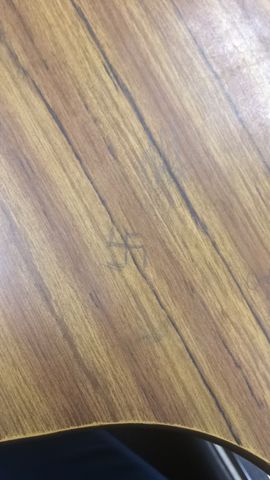A few strokes of graphite, easily erased. Technically speaking, that’s all it was.
My initial reaction upon finding a swastika drawn on my desk, where my Hebrew 1B class and other sections of Hebrew are held, was somewhat one of indifference. “These things happen all the time, right?” I thought.
But then my eyes opened up to the symbolism of the image in front of me, and I realized the errors in my thinking. First, that since “these things” happen frequently, I do not find them significant or meaningful. And second, that I was assuming a freshly-drawn swastika in the 21st century poses no threat to be or to my loved ones.
This thinking is the result of prevalent modern-day violence and anti-Semitism against Jews, both in Israel and on college campuses around the world. According to the FBI’s Uniform Crime Reporting Program, 57 percent of religiously-targeted hate crimes are committed against Jews. About a year ago, the house of UC Davis Jewish fraternity Alpha Epsilon Pi was vandalized with large, red swastikas. Our very own campus was faced with the infamous incident of Rachel Beyda last year, when her qualification for the Judicial Board was questioned because of her identity as a Jew.
However, Jewish targets of hate in the United States are lucky compared to those in Europe, where the swastika first originated as a symbol of Nazi terror. While the swastika holds religious significance in Hindu and Buddhist cultures as a sign of good luck, most Westerners identify the symbol as that adopted by the fascist Nazi party prior to World War II. People today continue to associate the swastika with the outrageously bigoted ideals that dominated the Third Reich in Germany under Adolf Hitler.
Despite the strong feelings we get from hearing about swastika sightings and the like, we seem to link the symbol with events of the past, rather than the here and now, and neglect to recognize the fact that the occurrence of another Holocaust is in fact possible. Decades after the horrific Holocaust which slaughtered 6 million Jews and 5 million others, terror attacks such as the murder of Jews in a kosher supermarket in France and the shooting in a Copenhagen synagogue last year have unleashed ripples of fear throughout the so-called ‘progressive West’.
This year, the epicenter of Jewish hate has centered in the Jewish State itself in what many are calling the Third Intifada. According to the Israel Ministry of Foreign Affairs, in the past five months alone, Palestinian terrorists have targeted Israelis in 193 stabbings, 77 shootings and 39 vehicular attacks. Not only do Palestinian terror groups continue to send rockets into Israel at an alarming rate, but now individuals have taken to the streets, committing crimes against Jews one-on-one.
Ironically, the more headlines flood with instances of Jewish stabbings or lesser acts of hate, the less the public is inclined to react outraged towards these acts. Thus, society has become desensitized to the kinds of horror committed against Jews that would elicit responses of shock if inflicted on other groups.
However ephemeral the figure on my desk was, its message made an impression in my mind that lasted weeks after I erased it. Whether it be a wedding ring, a flag or a swastika etched in pencil, symbols are an important marker of human society, and oftentimes their messages scream louder than words. The message I got from the symbol in front of me may as well have been, “I hope you die, I hope your family dies, and I hope the world turns a blind eye to your people’s suffering.”
It is improbable to know just who drew the swastika I found on my desk, and for what reason they chose to draw it. Was it an avid anti-Semite enrolled in the non-Hebrew class right after mine? Was it a non-Jew in one of the Hebrew sections who felt threatened by the Jewish majority? Or maybe an immature Jewish student who was waiting for some kind of response?
Whomever it was, I cannot say for certain that you receive the shock you intended, but I can assure you that whatever hateful message you were trying to send, the united voice of my nation projects back much louder.

